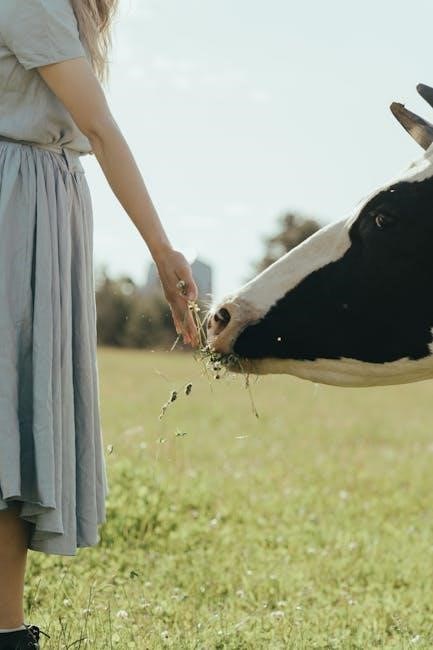Field dressing an elk is a critical step in preserving meat quality‚ ensuring proper cooling‚ and preventing contamination. It requires precision‚ the right tools‚ and attention to detail.
What is Field Dressing?
Field dressing is the process of removing an elk’s internal organs to cool the carcass quickly‚ preventing spoilage and maintaining meat quality. It involves making precise incisions to access the abdominal cavity‚ carefully extracting organs‚ and ensuring minimal contamination. This step is crucial for hunters to preserve the integrity of the meat before further processing or transportation. Proper field dressing requires knowledge of anatomy‚ the right tools‚ and attention to hygiene to ensure a clean and efficient process that honors the animal and safeguards the harvest.
Why Field Dressing is Important for Meat Quality

Field dressing is essential for maintaining the quality and safety of elk meat. By removing internal organs‚ the carcass cools faster‚ preventing bacterial growth and spoilage. Quick cooling preserves the meat’s texture and flavor‚ reducing the risk of contamination. Proper field dressing also prevents enzymes in the organs from breaking down the meat‚ which can lead to off-flavors. This step ensures the elk remains clean‚ fresh‚ and suitable for consumption‚ making it a critical process for hunters seeking high-quality venison.

Tools and Equipment Needed
A sharp knife‚ gloves‚ and game bags are essential. Additional gear includes a saw for cutting bone‚ lighting for visibility‚ and disposable tarps for clean processing.
Essential Knives and Cutting Tools
A sharp boning knife is indispensable for field dressing an elk‚ as it allows precise cuts through tissue and around bones. A gut hook knife can simplify the process of opening the abdomen safely. Additionally‚ a sturdy saw is necessary for cutting through the ribcage and pelvis. Durable gloves protect your hands‚ while a whetstone ensures your blades remain sharp. Proper tools are critical to avoid contamination and ensure efficient processing of the elk carcass.
Other Necessary Gear for Field Dressing
Besides knives‚ essential gear includes game bags to store organs and prevent contamination. A headlamp provides light for field dressing in low-light conditions. Disposable gloves and a plastic tarp protect against biohazards and simplify cleanup. A first-aid kit is crucial for personal safety. Additionally‚ rope or straps can help maneuver the carcass‚ while a portable cooler or ice keeps the meat fresh during transport. Proper equipment ensures efficiency and hygiene‚ maintaining meat quality and reducing waste.
Begin by preparing the elk‚ then make a precise incision to expose the cavity. Carefully remove organs‚ ensuring minimal damage to surrounding tissue; Cool the carcass promptly.

Step-by-Step Guide to Field Dressing
Preparing the Elk for Field Dressing
Position the elk on its back‚ ensuring the area is clean and flat. Secure the legs apart using rope or sticks for easy access. Wipe the abdominal area with a clean cloth or paper towels to prevent contamination. Remove any loose debris or dirt that may interfere with the process. Ensure all tools‚ such as knives and gloves‚ are within reach. This preparation step is crucial for maintaining hygiene and making the field dressing process efficient and safe.

Making the Initial Incision
Start by placing the elk on its back with legs secured. Locate the anus and make a small incision just through the skin‚ being careful not to cut too deeply. Use a sharp knife to continue the incision along the belly‚ cutting from the anus to the base of the jaw in one steady‚ smooth motion. Avoid cutting too deeply to prevent puncturing organs‚ which could contaminate the meat. Keep the knife close to the spine to maintain control and ensure a clean cut. This step is vital for accessing the organs quickly and efficiently.
Removing Organs and Cooling the Carcass
After making the initial incision‚ carefully cut around the anus and genitals to avoid contamination. Use a saw or knife to separate the pelvic bone for easier organ removal. Gently pull the organs away from the diaphragm and ribcage‚ taking care not to puncture the stomach or intestines. Once organs are removed‚ prop the body open to maximize airflow and cool the carcass quickly. This step is crucial for preventing spoilage and ensuring high-quality meat. Immediate cooling helps maintain the integrity of the elk’s flesh.
Safety and Hygiene Considerations
Always wear gloves and protective gear to prevent contamination and exposure to biohazards. Ensure clean tools and hands to maintain meat quality and safety during field dressing.
Preventing Contamination
Preventing contamination is crucial during field dressing to ensure the elk meat remains safe and high quality. Use clean‚ sharp tools to avoid spreading bacteria‚ and wear gloves to minimize direct contact with organs. Always work on a clean surface‚ such as a tarp or game bag‚ to catch any debris. Keep the carcass away from dirty water‚ soil‚ and other contaminants. Regularly sanitize tools with alcohol or bleach solution between cuts to maintain hygiene standards.
Protecting Yourself from Biohazards
Protecting yourself from biohazards is essential when field dressing an elk. Wear disposable gloves and consider using a face mask to avoid exposure to bodily fluids. Use eye protection to prevent splashes from reaching your eyes. Always sanitize tools and hands with bleach or alcohol after handling organs. Avoid eating or drinking while working on the carcass. Wash thoroughly with soap and water afterward to ensure safety and prevent any potential health risks. Proper gear reduces exposure to harmful pathogens and bacteria.

Tips for Beginners
For beginners‚ practice field dressing on smaller animals first. Consider taking a hands-on course or watching detailed tutorials. Keep tools sharp and organized‚ and stay calm.
Common Challenges and Solutions
Beginners often struggle with making precise cuts and navigating complex anatomy. To address this‚ practice on smaller game beforehand and use detailed guides or videos for reference. Additionally‚ keeping tools sharp and maintaining a clean workspace can prevent contamination and make the process smoother. If unsure about a step‚ consider seeking guidance from an experienced hunter or mentor to ensure the elk is dressed efficiently and safely.
Resources for Further Learning
A free PDF guide on elk field dressing offers detailed step-by-step instructions‚ photos‚ and expert tips for a successful process‚ ensuring high-quality meat preservation and safety.
Recommended PDF Guides and Tutorials
Downloadable PDF guides provide comprehensive instructions for field dressing an elk‚ featuring step-by-step photos and expert tips. These resources often include detailed diagrams‚ ensuring clarity for beginners. Many guides emphasize proper techniques to avoid contamination and preserve meat quality. Some tutorials also cover post-field dressing steps‚ such as quartering and transporting the carcass. Look for guides endorsed by experienced hunters or wildlife organizations for reliable‚ proven methods. These resources are invaluable for both novice and experienced hunters seeking to refine their skills.
Common Mistakes to Avoid
Avoiding improper incisions‚ delayed organ removal‚ and insufficient cooling is crucial. These mistakes can degrade meat quality and lead to contamination‚ rendering the elk inedible.
Errors That Can Compromise Meat Quality
Common errors include delayed field dressing‚ improper incisions‚ and failure to cool the carcass promptly. These mistakes can lead to contamination‚ spoilage‚ and poor meat quality. Additionally‚ not removing organs carefully can cause punctures‚ releasing bacteria. Insufficient bleeding and poor handling of the carcass can also degrade the meat. Avoiding these errors ensures the elk remains fresh and safe for consumption‚ preserving its natural flavor and texture for future meals.
Environmental Considerations
Proper waste disposal and using biodegradable materials are essential. Always follow local regulations to ensure sustainable practices and minimize ecological impact during field dressing.
Proper Disposal of Waste
Dispose of elk organs and waste responsibly in designated areas or bury them deeply to prevent attracting scavengers. Avoid water sources to maintain ecosystem health and comply with local regulations. Ensure all materials like gloves and disposable gear are properly bagged and disposed of in trash receptacles. This practice helps preserve the environment and supports ethical hunting standards. Always check local guidelines for specific rules on waste disposal in the area where you hunt.

Preserving the Quality of the Meat
Cooling the carcass immediately after field dressing is crucial to preserve meat quality‚ prevent bacterial growth‚ and ensure safe handling and transportation.
Cooling and Transporting the Carcass
Cooling the elk carcass immediately after field dressing is essential to prevent spoilage and maintain meat quality. Use game bags to protect the meat from dirt and insects while allowing airflow. Transport the carcass to a cooler or refrigerated space as soon as possible. Keep the carcass clean and dry during transport to avoid contamination. If delays occur‚ use ice packs or ice in a sealed container to keep the meat cool. Proper handling ensures fresh‚ high-quality venison for processing.
Field dressing an elk is a crucial skill for hunters‚ ensuring high-quality meat and responsible game management. Proper techniques preserve the harvest and honor the animal.
Final Thoughts on Successful Field Dressing
Mastering field dressing requires patience‚ practice‚ and adherence to proper techniques. Ensuring the carcass is cooled quickly and kept clean guarantees the best meat quality. Hunters must stay organized‚ use the right tools‚ and respect the animal. Remember‚ careful handling from the field to processing honors both the hunt and the elk. Always follow safety guidelines to avoid contamination and biohazard exposure. Taking pride in this step ensures a successful and ethical harvest every time.

Leave a Reply
You must be logged in to post a comment.